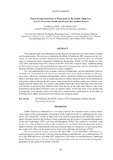| dc.contributor.author | Saadon, Nasir | |
| dc.contributor.author | Kin, Lim Phaik | |
| dc.contributor.author | Snidvongs, Anond | |
| dc.contributor.author | Rojana-Anawat, Penjan | |
| dc.date.accessioned | 2019-01-16T08:16:53Z | |
| dc.date.available | 2019-01-16T08:16:53Z | |
| dc.date.issued | 1999 | |
| dc.identifier.citation | Saadon, N., Kin, L. P., Snidvongs, A., & Rojana-Anawat, P. (1999). Physical characteristics of watermass in the South China Sea, Area II: Sarawak, Sabah and Brunei Darussalam waters. In Proceedings of the Second Technical Seminar on Marine Fishery Resources Survey in the South China Sea, Area II: West Coast of Sabah, Sarawak and Brunei Darussalam, 14-15 December 1998, Kuala Lumpur, Malaysia (pp. 1-22). Samut Prakan, Thailand: Training Department, Southeast Asian Fisheries Development Center. | en |
| dc.identifier.uri | http://hdl.handle.net/20.500.12067/809 | |
| dc.description.abstract | This study provides new information on the physical characteristics of water masses in Sabah and Sarawak waters. The aim was to determine the effect of Southwest (SW) monsoon on the variability of water masses, in Sabah and Sarawak waters. Physical characteristics data were obtained using an instrument called “Integrated Conductivity Temperature Depth” (iCTD), during the third (July 1996) and fourth (May 1997) cruises of the MV SEAFDEC research vessel, conducted during the SW monsoon season. Vertical distributions and profiles of temperature, salinity and density were analyzed and their variations between the two cruises compared.
It is concluded that there were no great variations of temperature, salinity and density values in the study area, during both cruises. This is because both cruises were conducted during the SW monsoon season. However, variations of temperature, salinity and density values were observed between shallow and deep waters, as well as coastal and offshore waters. Based on their vertical distributions and profiles obtained during the two cruises, water properties in shallow waters were found to vary slightly from the deeper ones. As a result, in the southern tip of the South China Sea, where the water was shallow, its properties here differed a little from the rest of the study area. This was due to the pronounced mixing effect of surface waves in shallow waters. At the same time, lower salinity and consequently, lower density values were detected in coastal waters, resulting from of the influx of freshwater from Sabah and Sarawak rivers during this monsoon season. | en |
| dc.language.iso | en | en |
| dc.publisher | Training Department, Southeast Asian Fisheries Development Center | en |
| dc.subject | South China Sea | en |
| dc.subject | Sarawak | en |
| dc.subject | Malaysia | en |
| dc.subject | Sabah | en |
| dc.title | Physical Characteristics of Watermass in the South China Sea, Area II: Sarawak, Sabah and Brunei Darussalam Waters | en |
| dc.type | Conference paper | en |
| dc.citation.spage | 1 | |
| dc.citation.epage | 22 | |
| dc.subject.asfa | salinity data | en |
| dc.subject.asfa | Water masses | en |
| dc.subject.asfa | physical oceanography | en |
| dc.subject.asfa | density | en |
| dc.subject.asfa | temperature data | en |
| dc.subject.asfa | Vertical profiles | en |
| dc.subject.asfa | monsoons | en |
| dc.citation.conferenceTitle | Proceedings of the Second Technical Seminar on Marine Fishery Resources Survey in the South China Sea, Area II: West Coast of Sabah, Sarawak and Brunei Darussalam, 14-15 December 1998, Kuala Lumpur, Malaysia | en |

